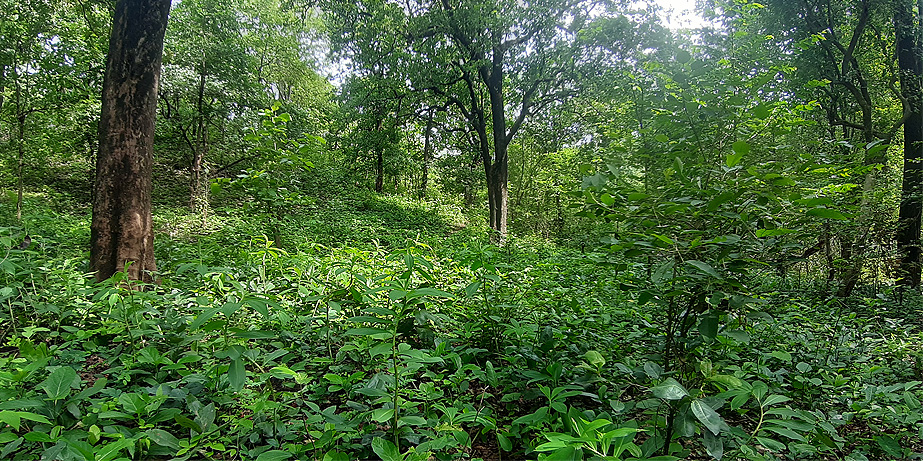| |
|

Sitamata is one of the richest sanctuaries from the biota point of
view. Nearly 50 species of mammals, more than 325 species of birds
40 species of reptiles, 9species of amphibians, 30 species of fishes
and more than 800 species of plants have been listed in the
Sanctuary .This Sanctuary can be considered as “hot spot” of
Rajasthan for floral and faunal diversity point of view Northern
moist distribution limit of many duccan elements are passing through
the Sitamata. Flying Squirrels, Four horned antelope, Tree snakes,
Tree Frog, Ratal, Indian pangolin ,etc. can be seen here .This
Sanctuary is famous for Four horned Antelopes and considered as best
Chousinga Sanctuary of state.
Birds like Grey jungle fowl, Aravlli red spur fowl, yellow footed
Green Pigeon, Alexandrine parakeet, Stork-billed kingfisher, Indian
pitta, Black -headed oriole, Indian paradise Flycatcher,
Black lored tit, Purple-rumped sun bird, Monarach, ultra-marine
verditor flycatchers etc. can be seen in sylvan environs of the
Sitamata .Lesser Floricans are worth seeing over here during mansoon
at eastern outskirts of Sanctuary Sitamata Sanctuary is very rich in
floral elements too. It is famous for climbers, lianas, tuberous
plants and orchids ,Leea macrophylla, costus species, Firmiame
locorata,Buchanania lanzan,Oroxylum indicum, Steeospermum shaveolens,
Euphorbia acanalis, Neurocanthus spliocrostachys, Artennisiani
lagirica, Nervilia aragoane , Vanda tessellata, Curcuma
pseudomontana, Peperomia pellucida ,etc.are important rare species
as far as Rajasthan is concern. These species are fairly in good
number over here. Sitamata is also rich in Ferns and Bryophyte.
Sitamata is also known for medicinal plants As many as 108 species
of medicinal plants have already been identified , Sitamata forest
harbors 13 of the 32 endangered medicinal plants listed by National
Medicinal plant board New-Delhi.
FOREST TYPE AND SPECIES: - The floral constituents of
the Sitamata wildlife Sanctuary are mostly edaphoclimax .As per the
Champion & Seth’s classification the forest of this sanctuary falls
under II category of Tropical Dry Deciduous Forest, which can be Sub
classified as:
Group 5: Tropical Dry deciduous Forest
Sub Group 5B: Northern Tropical Dry deciduous forest
C2 Northern Tropical Dry mixed deciduous forest 6
The main species dominating are Tectona grandis(teak/sagwan),
Wrigtia tintoria, Boswellia serrata, Lannea grandis ,Madhuca
indica(mahua), Pongamia pinnata, Dendrocalamus strictus , Sterculia
urens, Butea monosperma , Anogeisus latifolia, Syzygium heynnainum,
Adina cardifolia ,Diospyrus malanoxylon, orchids , tuberos plants
etc.
Historical Importance
As the name itself explains its historical & religious importance
that people believes that Devi Sita spent her days of exile in this
forest, where the ashram of rishi Valmiki was situated thus
sanctuary bears the name of Devi sitamata and her famous temple is
situated in the Heart of the forest area of sanctuary.
Location
Sitamata Wildlife Sanctuary is situated in the South-East region of
the Rajasthan in Chittorgarh, Pratapgarh & Udaipur Districts; where
three very ancient mountain ranges of India namely The Aravallis,
The Vindhyas and Malva Plateau meet together forming the
Northwestern limits of Teak Forest. This results in to unique
Biodiversity many species are yet to discovered and identified from
this area. Sitamata is situated between 74° 25'E and 74° 40'E East
longitude and 24° 04"N and 24° 23' Northern Latitude.
Approach
Sitamata Wildlife Sanctuary lies on Udaipur Pratapgarh State highway
at a distance of 100 km. and 60 kms from Udaipur and Chittorgarh
respectively. Nearest Railway station is Chttorgarh. Whereas the
nearest Airport is Maharana Pratap (Dabok) Airport Udaipur at a
distance of 80kms. Taxies are available from all these places to
reach The Sanctuary.
Topography
The configuration of land is hilly and rugged with high altitude
which varies from 280 to 600 mt. The general slope of the land id
from North-West to South-East. The network of perennial rivers and
presence of riparian vegetation is main characteristic of the
sanctuary. the Jakham, The Karmoi and Sitamata perennial rivers
flows through the Sanctuary.
Climate
The climate of this region is quite pleasant with subtropical
feature and characterized by district winter, summer and rainy
season. Average rainfall is 756mm and mercury seldom falls below 6°
in winter and never rises above 45 in summer.
Visiting Season
Best Season for visiting this Sanctuary is from October to February
and Sanctuary is open up to June.
Timing for visit the Sanctuary - Sunrise to Sunset.
 |
|



